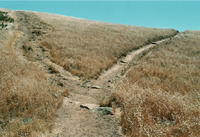Items
Site
The Medicine Chest
keywords is exactly
walking
-

Miscast (Lane reflects)
"Where viewers had to walk over a floor of vinyl tiles printed with photocopied newspaper articles and photographs of the San, Lane reflected on another archaeological parallel: ‘just as the texts and images on the floor represent the debris of a particular history, so too do the artefacts strewn across the surface of a site’ (Lane 1996: 7). Yet in trying to define sites and their history, archaeologists feel ‘they can tread on the debris of their own or others’ ancestors with equanimity, colonizing that space for themselves’ (Lane 1996: 7)" (Liebenberg 2021: 172 - 174). -

Or
"The processes of digression and diversion have much in common with what the writer Ross Chambers (1999) calls ‘loiterature’. Chambers investigates the digressive, category-blurring genre of writing found in works such as Nicholson Baker’s 'The mezzanine', Paul Auster’s 'City of glass' and Laurence Sterne’s 'Tristam Shandy'. Loiterly writing, according to Chambers, disarms criticism by providing a moving target, shifting as its own divided attention constantly shifts. Criticism depends on the opportunity to discriminate and hierarchise, determining what is central and what is peripheral (Chambers 1999: 9), which this form eludes by resisting contextualisation or singular categorisation. Loiterature promotes sites of endless intersection, where attention is always divided between one thing and some other thing, always willing and able to be distracted, contrasting ‘the disciplined and the orderly, the hierarchical and the stable, the methodical and the systematic’ (Chambers 1999: 10). In contrast to methods of science that seek to stabilise objects within taxonomic systems or that require the formulation of hypotheses to provide direction for experimentation and a basis for concrete outcomes, the processes of curatorship and artmaking revel in rerouting and redirecting and in diversion and digression" (Liebenberg 2021: 286). -

“I am just going outside and may be some time"
After initially making good progress, Terra Nova expedition party’s prospects steadily worsened as they struggled northward. Deteriorating weather, frostbite, snow blindness, hunger and exhaustion led to Edgar Evans dying on 17 February and Lawrence Oates, whose condition was aggravated by an old war-wound to the extent that he was barely able to walk, voluntarily leaving his tent on 16 March and walking to his death. (“I am just going outside and may be some time".)" (Liebenberg 2011: 75). -

A letter to Barrie
My dear Barrie, We are pegging out in a very comfortless spot. Hoping this letter may be found and sent to you, I write a word of farewell.... More practically I want you to help my widow and my boy – your godson. (...) I am not at all afraid of the end, but sad to miss many a humble pleasure which I had planned for the future on our long marches. I may not have proved a great explorer, but we have done the greatest march ever made and come very near to great success. Goodbye, my dear friend. Yours ever, R. Scott. (Excerpt from letter penned by Scott to Barrie on 29 March 1912) -

Resonance (Greenblatt)
In 'Resonance and Wonder' Greenblatt discusses ‘resonant’ moments in regards to museum displays as “those in which the supposedly contextual objects take on a life of their own and make a claim that rivals that of the object that is formally privileged. A table, a chair, a map – often seemingly placed only to provide a decorative setting for a grand work – become oddly expressive, significant not as a background but as compelling representational practices in themselves. These practices may in turn impinge on the grand work, so that we begin to glimpse a kind of circulation: the cultural practice and social energy implicit in mapmaking is drawn into the aesthetic orbit of a painting, which has itself enabled us to register some of the representational significance of the map” (1991: 22- 23). For him a resonant exhibition often “pulls the viewer away from the celebration of isolated objects and toward a series of implied, only half-visible relationships and questions” (1991: 23). -

Resonance
Image from page 137 of the 'Curiosity CLXXV' catalogue, describing resonance and its application in MRI technology.


